IMPORTANT: Beware of “Meadow in a Can” type mixes! They’re often a mix of annual, sometimes non-native, sometimes invasive plants that won’t create an ecologically useful meadow!
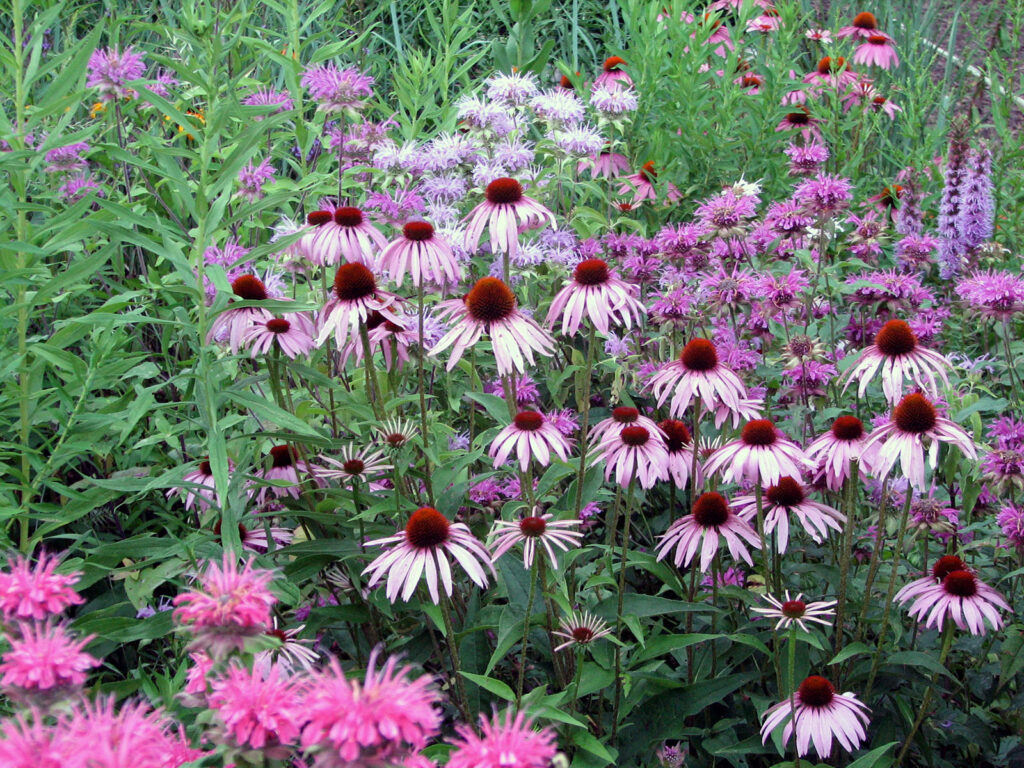
We call this area of our back yard our meadow, but basically, it’s a sunny area where we plant native grasses and meadow-type native flowers.
I had originally planted only flowering plants, but added some native grasses after reading Sara Stein (see Reflections below).
We try to plant mostly lower-growing plants in the front and higher-growing plants in the back. We tried not to make this height progression too rigid, though (as if we could), because it would look too formal and perhaps might not be as appealing to wildlife.
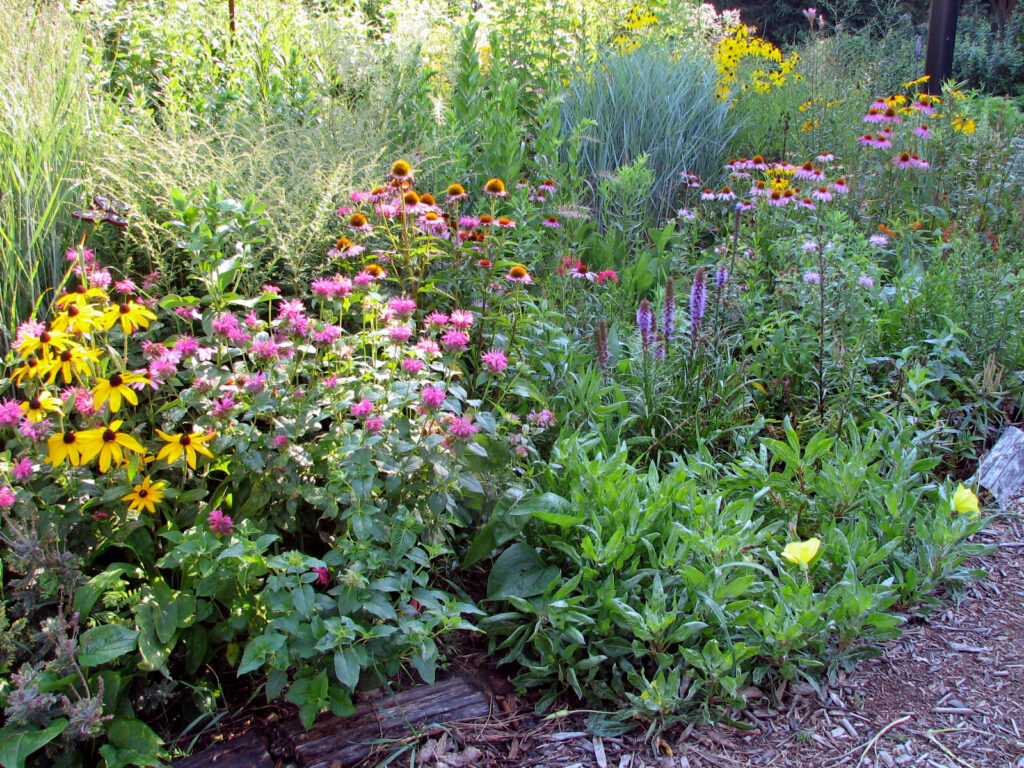
Some of the flowers are monarda (Monarda fistulosa), liatris (Liatris spicata), brown-eyed Susan (Rudbeckia hirta), gray coneflower (Ratibida pinnata), prairie smoke (Geum triflorum), and purple coneflower (Echinacea purpurea), among others.
Some of the grasses are switchgrass (Panicum virgatum), little bluestem (Schizachryrium scoparium), blue grama (Bouteloua gracilis), and others.
We have a mixture of native plants all growing together. The mixture changes as some plants spread and others decline, but the variety is appealing to creatures and to us.
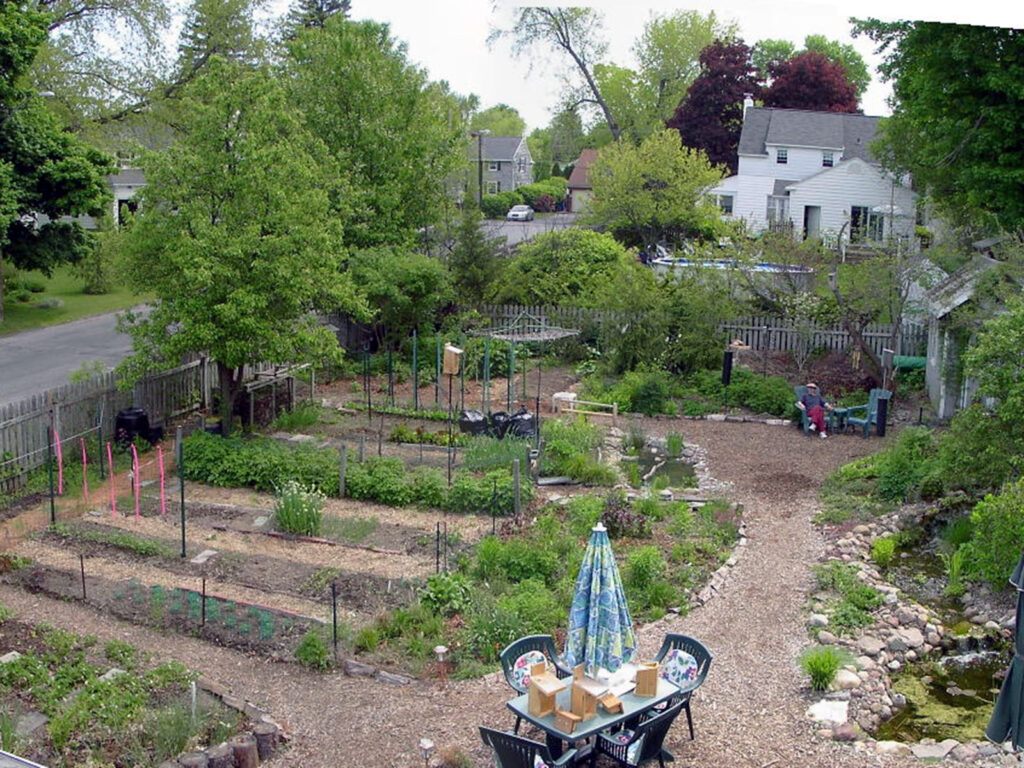
An unforeseen advantage is its location in front of our edible garden: it attracts a wealth of pollinators that helps keep our fruits and vegetables producing delicious produce.
It’s also an ideal “grocery store” for birds and even spiders looking for some tasty insects attracted by the flowers.
Another native grass area in our back yard
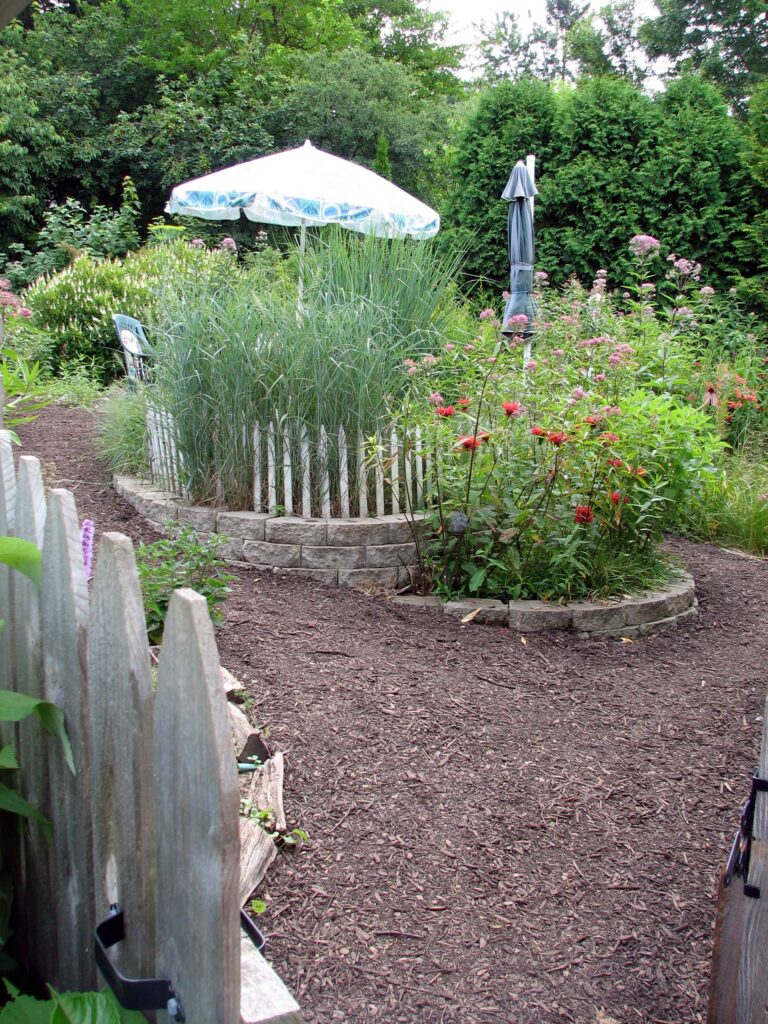
Our back yard is entirely enclosed by a wooden fence. There’s no lawn at all. The path to the left goes toward the back on a gentle slope, and the path to the right goes to the door to the garage and to the sliding door to enter the house.
Our edible garden has had permanent beds — and hence permanent paths — since we first created our edible garden area as soon as we moved there. We protect the soil by not walking on it.
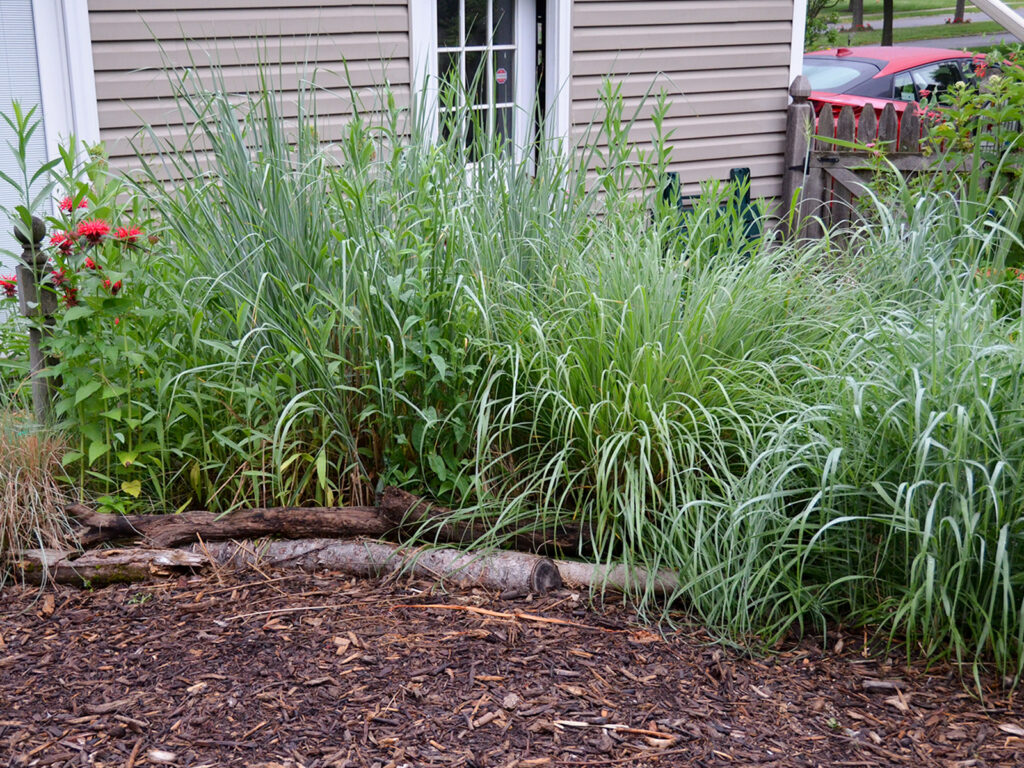
At first, we planned on using this just as a sitting area, but I became concerned about the sitting area backing up to a drop-off to the path below, so we decided to plant grasses there.
We built this area up to make it level with the main part of the sitting area between the house and the pond. To build it up, we used buckets of sod we collected from the curb. (Someone had put a lot of topsoil out to the curb when they were installing a fence. How can people put TOPSOIL out to the curb along with trash!)
That wasn’t enough to build up this area, so we also filled it in with some extra cinder blocks we had lying around. For a while, I worried first whether it was a good idea to put cinder blocks in soil, and second, how long these grasses would continue to thrive when at least some of their roots must be exposed to air pockets in the cinder blocks.
Now about twenty years later, these grasses still seem to be thriving, so I guess it worked out!
And it turned out that bumble bees approved of this area! We were delighted to watch this bumble bee colony throughout the summer when they nested in this native grass area.
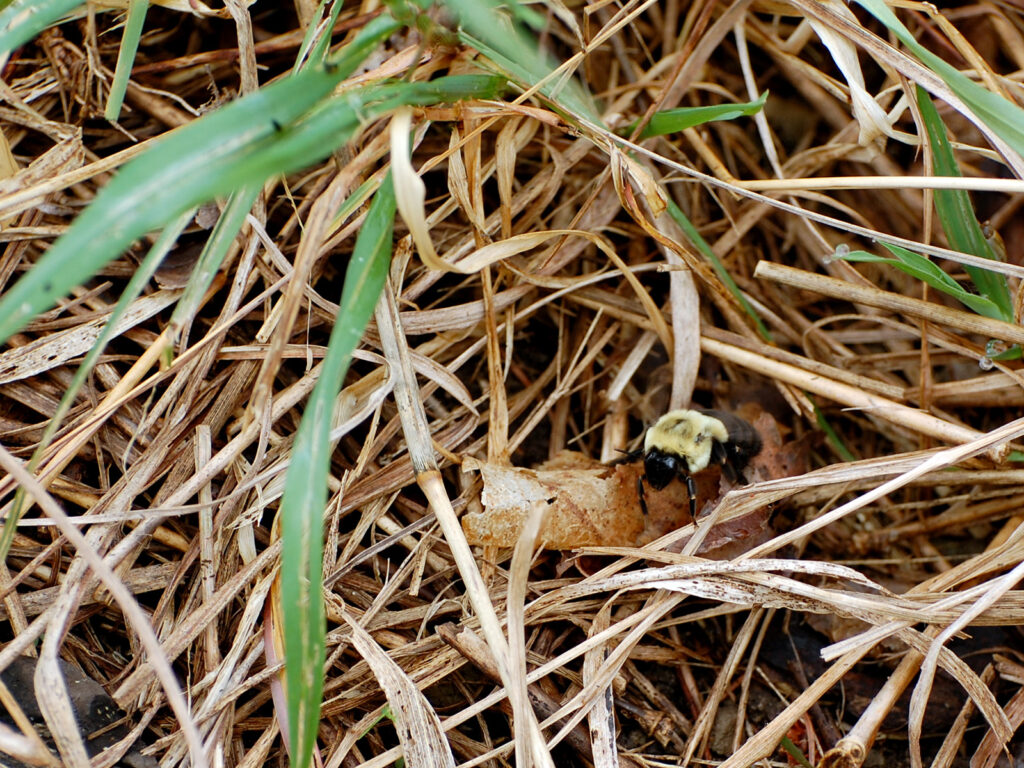
Resources
- Catherine Zimmerman:
- BOOK and VIDEO: The Meadow Project [NOTE: The book has been revised since its 2010 edition.]
- Owen Wormser
- BOOK: Lawns into Meadows
- Xerces Society:
- Cornell Cooperative Extension:
- Penn State Extension:
- Wild Seed Project (Maine):
- Ecological Landscaping Alliance:
- Appleton Post-Crescent:
- Appleton’s bee population increases in abundance and diversity with No Mow May – Describes an local Appleton Wisconsin experiment that found: A sampling of No Mow May lawns last week found a fivefold increase in bee abundance and a threefold increase in bee diversity in comparison to nearby parkland that was mowed regularly.
Reflections
It seems perverse that what in nature is the very matrix of flower gardens entered the horticultural vocabulary as “accent plants” or “ornamental grasses.” If a garden is a patch of plants that works without requiring work — that proceeds realistically from original conditions to a self-sustaining system — then gardens must be bedded down with grass. Grass is to meadow flowers as water is to fish: their medium. Even lawn weeds know that.
~ Sara Stein, Planting Noah’s Garden, p. 27
That gifts were being offered was evident in the general hum and flutter of insect life. The meadow was audible with bees and crickets; the mowed grass was silent. The meadow waved and nodded in the wind; crowds of leaf hoppers leapt to the brush of a hand. The lawn was deadly still.
~ Sara Stein, Noah’s Garden: Restoring the Ecology of Our Own Back Yards, 1993, p. 140
Although there are many different types of native meadows, they generally have one thing in common. The plant group most vital for their stability are the warm-season grasses such as Little Bluestem (Schizachryrium scoparium), Indian grass (Sorghastrum nutans) and Panic grass (Panicum virgatum). Although wildflowers receive the bulk of attention and are certainly an important aesthetically pleasing portion of the mix, it is the grasses that provide the stability for successful long-term results. Only through a combination of warm-season grasses and tough native perennials selected for site adaptability can we create dynamic and colorful landscapes that can live up to the low-maintenance expectations surrounding the wildflower meadow.
~ Larry Weaner, Ten Elements of Natural Design
I appreciate the misunderstanding I have had with Nature over my perennial border. I think it is a flower garden; she thinks it is a meadow lacking grass, and tries to correct the error.
~ Sara Stein, My Weeds: A Gardener’s Botany, 2000
I think the meadow really evokes a connection to the earth and a sense of peace and calm …. but then when you walk into a meadow it’s so full of life; it’s just teeming. It’s noisy with the buzz of the pollinators, the chirping of the crickets, the flutter of the birds and the butterflies. It’s really alive. It’s much more than a field that needs to be mowed. It’s full of life.
~ Peggy Bowers, horticulturalist
